Remote Sensing-Based Rainfall Variability for Warming and Cooling in Indo-Pacific Ocean with Intentional Statistical Simulations
Abstract
:1. Introduction
2. Materials and Methods
2.1. Precipitation Dataset and Climate Change Indices
2.2. Indian Ocean Dipole (IOD) and El Niño–Southern Oscillation (ENSO)
2.3. Trend Detection
2.4. Intentionally Biased Bootstrapping Method
3. Results
3.1. Seasonal Precipitation Patterns across the ICP
3.2. Spatiotemporal Variation in Precipitation over the ICP
3.3. Precipitation Variability Associated With the IOD and ENSO
3.4. Identification of IOD-Sensitive Hotspots through IBB Simulations
4. Summary and Conclusions
- According to analyses of the long-term trend in seasonal rainfall across the ICP during 1979–2018, rainfall showed significant decreases in northern Cambodia, parts of Laos, and southern Thailand during the wet season (May–October). Moreover, significant increases were evident in northwestern Myanmar, some parts of western Thailand, central Vietnam, and southern China. During the dry season (November–April), PRCPTOT rose noticeably in eastern and southern coastal areas of the ICP (i.e., Vietnam and Cambodia) and some southern coastal regions of Thailand.
- During the wet season, the CDD index increased or decreased in some coastal areas such as Vietnam. However, during the dry season, increases in CDD and decreases in CWD were evident in the ICP. In particular, a pattern of decline in CWD dominated southeastern coastal areas of the ICP, including Vietnam, Cambodia, and southern Thailand.
- The IOD showed strong positive correlation with the CT El Niño. However, although the IOD exhibited positive correlation with the WP El Niño, the relationship was not statistically significant. The variability of rainfall pattern and amount across the ICP was confirmed to be amplified by combined and independent effects of ENSO and the IOD. During years of positive IOD and El Niño, there was less rainfall than usual throughout Thailand and Cambodia, southern Laos, and Vietnam. In particular, the southern part of Myanmar, which borders the Andaman Sea, showed a decrease in regional rainfall of >50% in comparison with the long-term average. In contrast, northern parts of India and China, including Myanmar, northeastern Laos, and Vietnam, received 20–40% more rainfall than usual. Years with a negative IOD mode and La Niña showed rainfall above the long-term average across the ICP, except for certain parts, e.g., Central Laos and northern Vietnam.
- Through application of the IBB technique, this study simulated the change of rainfall pattern and amount across the ICP for the wet and dry seasons according to intentional IOD changes, and IOD-sensitive hotspots were verified through quantitative analysis. For the wet season, a +1 SD increase of the IOD resulted in >90% more PRCPTOT than usual across Myanmar in the northwestern ICP. Conversely, in Cambodia and southern Vietnam, rainfall patterns were 15–20% less than the long-term average in the region of the lower Mekong River. In addition, the CDD index decreased throughout Myanmar by >25% compared with the long-term average. The most significant change in the CWD index was in Myanmar, i.e., a 35–50% increase. However, a pattern of decrease appeared across the southeastern coast of the ICP in southern Cambodia and Vietnam. For a +1 SD increase of the IOD in the dry season, negative anomaly patterns of PRCPTOT were found to be dominant in South Vietnam, eastern Cambodia, and northeastern Thailand, and more rainfall than usual occurred throughout the ICP, especially in Laos and Vietnam, when considering a −1 SD decrease of the IOD.
Author Contributions
Funding
Conflicts of Interest
References
- Allan, R.P.; Soden, B.J. Atmospheric warming and the amplification of precipitation extremes. Science 2008, 321, 1481–1484. [Google Scholar] [CrossRef] [PubMed] [Green Version]
- Kim, J.S.; Jain, S. Precipitation trends over the Korean peninsula: Typhoon-induced changes and a typology for characterizing climate-related risk. Environ. Res. Lett. 2011, 6, 034033. [Google Scholar] [CrossRef]
- Ge, F.; Zhi, X.; Babar, Z.A.; Tang, W.; Chen, P. Interannual variability of summer monsoon precipitation over the Indochina Peninsula in association with ENSO. Theor. Appl. Climatol. 2017, 128, 523–531. [Google Scholar] [CrossRef]
- Kang, H.Y.; Kim, J.S.; Kim, S.Y.; Moon, Y.I. Changes in High-and Low-Flow Regimes: A Diagnostic Analysis of Tropical Cyclones in the Western North Pacific. Water Resour. Manag. 2017, 31, 3939–3951. [Google Scholar] [CrossRef]
- Kim, J.S.; Son, C.Y.; Moon, Y.I.; Lee, J.H. Seasonal rainfall variability in Korea within the context of different evolution patterns of the central Pacific El Niño. J. Water Clim. Chang. 2017, 8, 412–422. [Google Scholar] [CrossRef]
- Gao, Q.; Kim, J.S.; Chen, J.; Chen, H.; Lee, J.H. Atmospheric Teleconnection-Based Extreme Drought Prediction in the Core Drought Region in China. Water 2019, 11, 232. [Google Scholar] [CrossRef]
- Chi, X.; Yin, Z.; Wang, X.; Sun, Y. Spatiotemporal variations of precipitation extremes of China during the past 50 years (1960–2009). Theor. Appl. Climatol. 2016, 124, 555–564. [Google Scholar] [CrossRef]
- Gu, X.; Zhang, Q.; Singh, V.P.; Shi, P. Changes in magnitude and frequency of heavy precipitation across China and its potential links to summer temperature. J. Hydrol. 2017, 547, 718–731. [Google Scholar] [CrossRef] [Green Version]
- Choi, J.H.; Yoon, T.H.; Kim, J.S.; Moon, Y.I. Dam rehabilitation assessment using the Delphi-AHP method for adapting to climate change. J. Water Resour. Plan. Manag. 2018, 144, 06017007. [Google Scholar] [CrossRef]
- Croitoru, A.E.; Chiotoroiu, B.C.; Todorova, V.I.; Torică, V. Changes in precipitation extremes on the Black Sea Western Coast. Glob. Planet. Chang. 2013, 102, 10–19. [Google Scholar] [CrossRef]
- IPCC: Climate change 2013: The Physical Science Basis. Contribution of Working Group I to the Fifth Assessment Report of the Intergovernmental Panel on Climate Change; Cambridge University Press: Cambridge, UK, 2013. [Google Scholar]
- Hirsch, R.M.; Archfield, S.A. Flood trends: Not higher but more often. Nat. Clim. Chang. 2015, 5, 198. [Google Scholar] [CrossRef]
- Donat, M.G.; Lowry, A.L.; Alexander, L.V.; O’Gorman, P.A.; Maher, N. More extreme precipitation in the world’s dry and wet regions. Nat. Clim. Chang. 2016, 6, 508–514. [Google Scholar] [CrossRef]
- Mirza, M.M.Q. Climate change and extreme weather events: Can developing countries adapt? Clim. Policy 2003, 3, 233–248. [Google Scholar] [CrossRef]
- Yin, J.; Yin, Z.E.; Zhong, H.D.; Xu, S.Y.; Hu, X.M.; Wang, J.; Wu, J.P. Monitoring urban expansion and land use/land cover changes of Shanghai metropolitan area during the transitional economy (1979–2009) in China. Environ. Monit. Assess. 2011, 177, 609–621. [Google Scholar] [CrossRef] [PubMed]
- Chen, D.; Cane, M.A. El Niño prediction and predictability. J. Comput. Phys. 2008, 227, 3625–3640. [Google Scholar] [CrossRef]
- Ashok, K.; Yamagata, T. The El Niño with a difference. Nature 2009, 461, 481–484. [Google Scholar] [CrossRef]
- Pradhan, P.K.; Preethi, B.; Ashok, K.; Krishna, R.; Sahai, A.K. Modoki, Indian Ocean Dipole, and western North Pacific typhoons: Possible implications for extreme events. J. Geophys. Res. 2011, 116, D18108. [Google Scholar] [CrossRef]
- Kim, J.S.; Zhou, W.; Wang, X.; Jain, S. El Nino Modoki and the summer precipitation variability over South Korea: A diagnostic study. J. Meteorol. Soc. Jpn. 2012, 90, 673–684. [Google Scholar] [CrossRef] [Green Version]
- Yoon, S.K.; Kim, J.S.; Lee, J.H.; Moon, Y.I. Hydrometeorological variability in the Korean Han River Basin and its sub-watersheds during different El Niño phases. Stoch. Environ. Res. Risk Assess. 2013, 27, 1465–1477. [Google Scholar] [CrossRef]
- Son, C.Y.; Kim, J.S.; Moon, Y.I.; Lee, J.H. Characteristics of tropical cyclone-induced precipitation over the Korean River basins according to three evolution patterns of the Central-Pacific El Niño. Stoch. Environ. Res. Risk Assess. 2014, 28, 1147–1156. [Google Scholar] [CrossRef]
- Wang, X.; Zhou, W.; Li, C.Y.; Wang, D.X. Comparison of the impact of two types of El Niño on tropical cyclone genesis over the South China Sea. Int. J. Climatol. 2014, 34, 2651–2660. [Google Scholar] [CrossRef]
- Piechota, T.C.; Chiew, F.H.S.; Dracup, J.A.; McMachon, T.A. Seasonal streamflow forecasting in eastern Australia and the El Niño-Southern Oscillation. Water Res. Res. 1998, 34, 3035–3044. [Google Scholar] [CrossRef]
- Saji, N.H.; Goswami, B.N.; Vinayachandran, P.N.; Yamagata, T. A Dipole Mode in the tropical Indian Ocean. Nature 1999, 401, 360363. [Google Scholar] [CrossRef] [PubMed]
- Mahala, B.K.; Nayak, B.K.; Mohanty, P.K. Impacts of ENSO and IOD on tropical cyclone activity in the Bay of Bengal. Nat. Hazards 2015, 75, 1105–1125. [Google Scholar] [CrossRef]
- Iqbal, A.; Hassan, S.A. ENSO and IOD analysis on the occurrence of floods in Pakistan. Nat. Hazards 2018, 91, 879–890. [Google Scholar] [CrossRef]
- Webster, P.J.; Moore, A.M.; Loschnigg, J.P.; Leben, R.R. Coupled ocean–atmosphere dynamics in the Indian Ocean during 1997–1998. Nature 1999, 401, 356–360. [Google Scholar] [CrossRef] [PubMed]
- Ashok, K.; Guan, Z.; Yamagata, T. Impact of the Indian Ocean Dipole on the relationship between the Indian monsoon rainfall and ENSO. Geophys. Res. Lett. 2001, 28, 4499–4502. [Google Scholar] [CrossRef] [Green Version]
- Ashok, K.; Guan, Z.; Yamagata, T. Influence of the Indian Ocean dipole on the Australian winter rainfall. Geophys. Res. Lett. 2003, 30, 1821. [Google Scholar] [CrossRef]
- McPhaden, M.J.; Zebiak, S.E.; Glantz, M.H. ENSO as an integrating concept in Earth Science. Science 2006, 314, 1740–1745. [Google Scholar] [CrossRef] [Green Version]
- Kosaka, Y.; Xie, S.P. Recent global-warming hiatus tied to equatorial Pacific surface cooling. Nature 2013, 501, 403. [Google Scholar] [CrossRef] [Green Version]
- Lee, S.K.; Park, W.; Baringer, M.O.; Gordon, A.L.; Huber, B.; Liu, Y. Pacific origin of the abrupt increase in Indian Ocean heat content during the warming hiatus. Nat. Geosci. 2015, 8, 445. [Google Scholar] [CrossRef]
- Liu, W.; Xie, S.P.; Lu, J. Tracking ocean heat uptake during the surface warming hiatus. Nat. Commun. 2016, 7, 10926. [Google Scholar] [CrossRef] [PubMed] [Green Version]
- Schneider, U.; Ziese, M.; Meyer-Christoffer, A.; Finger, P.; Rustemeier, E.; Becker, A. The new portfolio of global precipitation data products of the Global Precipitation Climatology Centre suitable to assess and quantify the global water cycle and resources. Proc. IAHS 2016, 374, 29–34. [Google Scholar] [CrossRef] [Green Version]
- Karl, T.R.; Nicholls, N.; Ghazi, A. Clivar/GCOS/WMO workshop on indices and indicators for climate extremes workshop summary. In Weather and Climate Extremes; Springer: Berlin, Germany, 1999; pp. 3–7. [Google Scholar]
- Ren, H.L.; Jin, F.F. Nino indices for two types of ENSO. Geophys. Res. Lett. 2011, 38, L04704. [Google Scholar] [CrossRef]
- Mann, H.B. Nonparametric Tests Against Trend. Econometrica 1945, 13, 245–259. [Google Scholar] [CrossRef]
- Kendall, M.G.; Gibbons, J.D. Rank Correlation Methods; Arnold, E., Ed.; Springer: Berlin, Germany, 1990. [Google Scholar]
- Hamed, K.H.; Rao, A.R. A modified Mann-Kendall trend test for autocorrelated data. J. Hydrol. 1998, 204, 182–196. [Google Scholar] [CrossRef]
- Davison, A.C.; Hinkley, D.V.; Young, G.A. Recent developments in bootstrap methodology. Stat. Sci. 2003, 18, 141–157. [Google Scholar] [CrossRef]
- Lee, T. Climate change inspector with intentionally biased bootstrapping (CCIIBB ver. 1.0)–methodology development. Geosci. Model Dev. 2017, 10, 525–536. [Google Scholar] [CrossRef] [Green Version]
- Gao, Q.G.; Sombutmounvong, V.; Xiong, L.; Lee, J.H.; Kim, J.S. Analysis of Drought-Sensitive Areas and Evolution Patterns through Statistical Simulations of the Indian Ocean Dipole Mode. Water 2019, 11, 1302. [Google Scholar] [CrossRef] [Green Version]
- Lestari, R.K.; Koh, T.Y. Statistical evidence for asymmetry in ENSO–IOD interactions. Atmos. Ocean 2016, 54, 498–504. [Google Scholar] [CrossRef]
- Yuan, Y.; Li, C. Decadal variability of the IOD-ENSO relationship. Chin. Sci. Bull. 2008, 53, 1745–1752. [Google Scholar] [CrossRef] [Green Version]
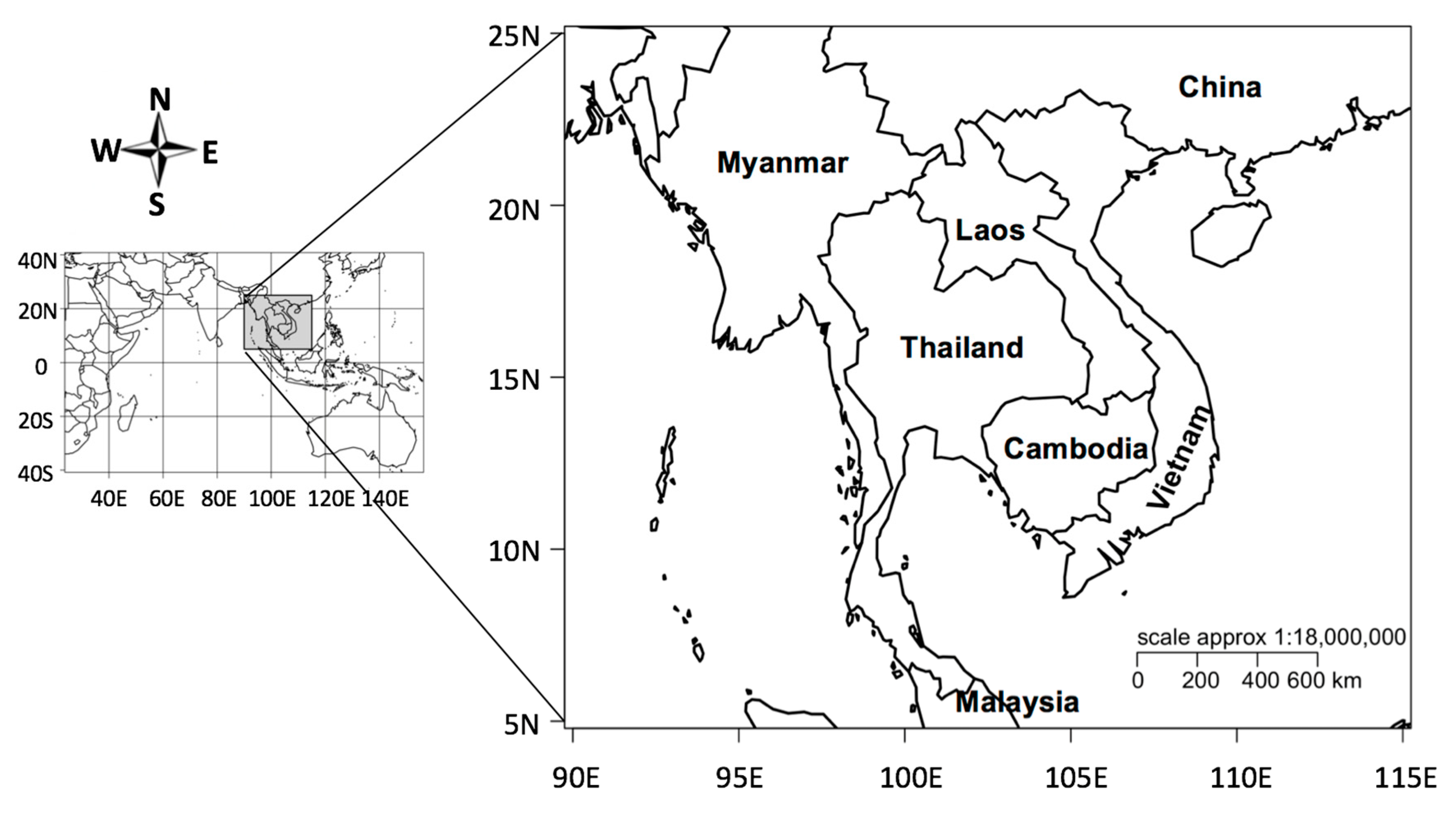
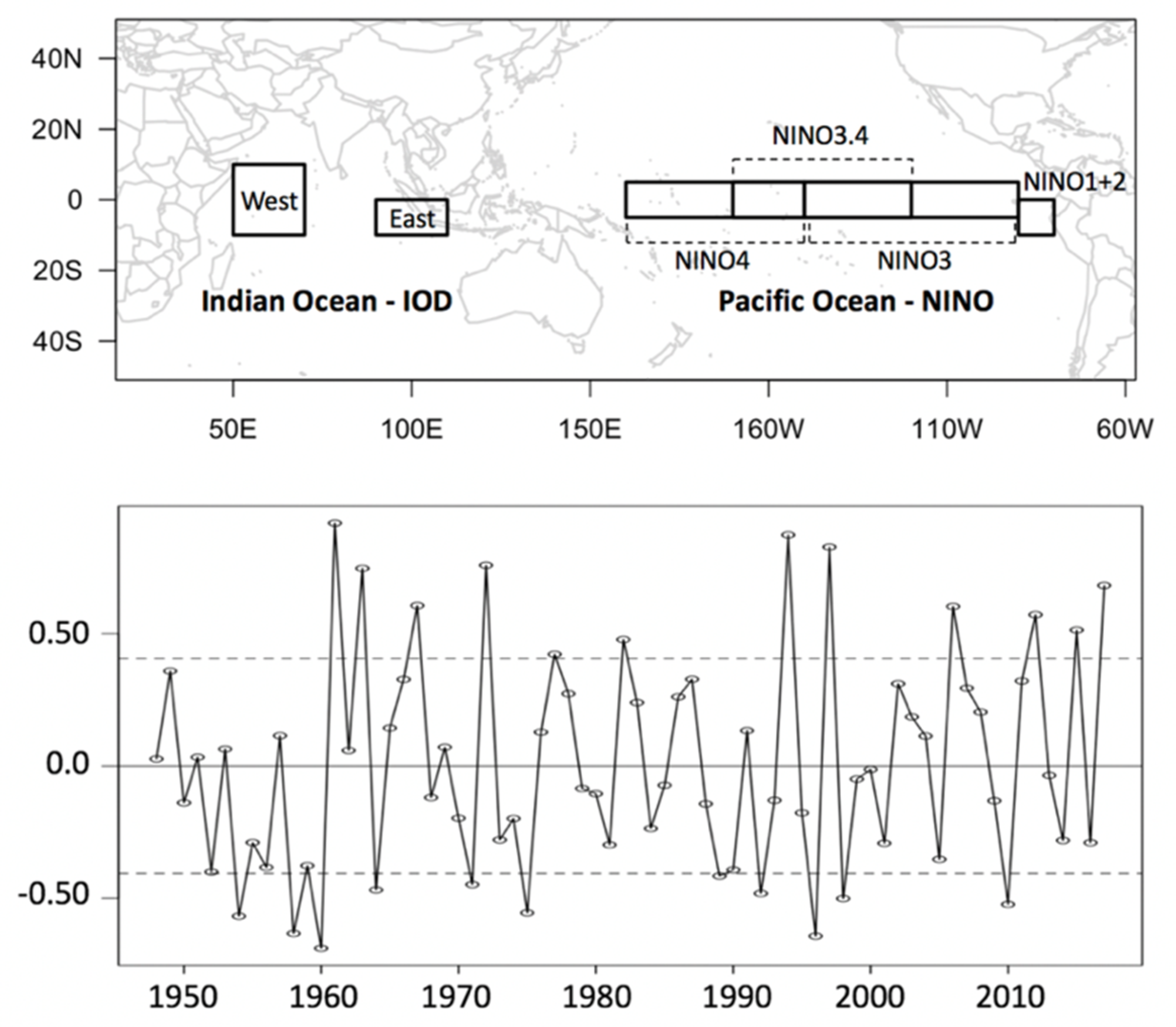

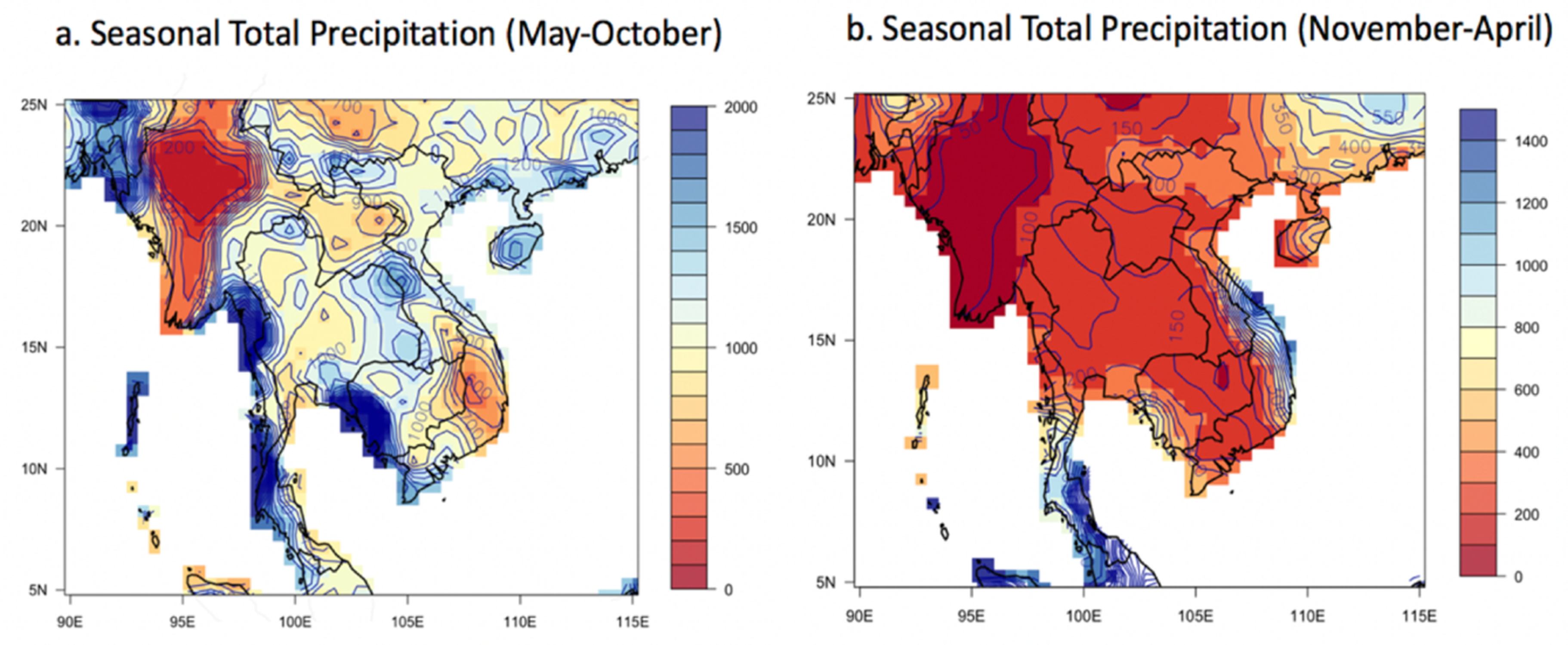

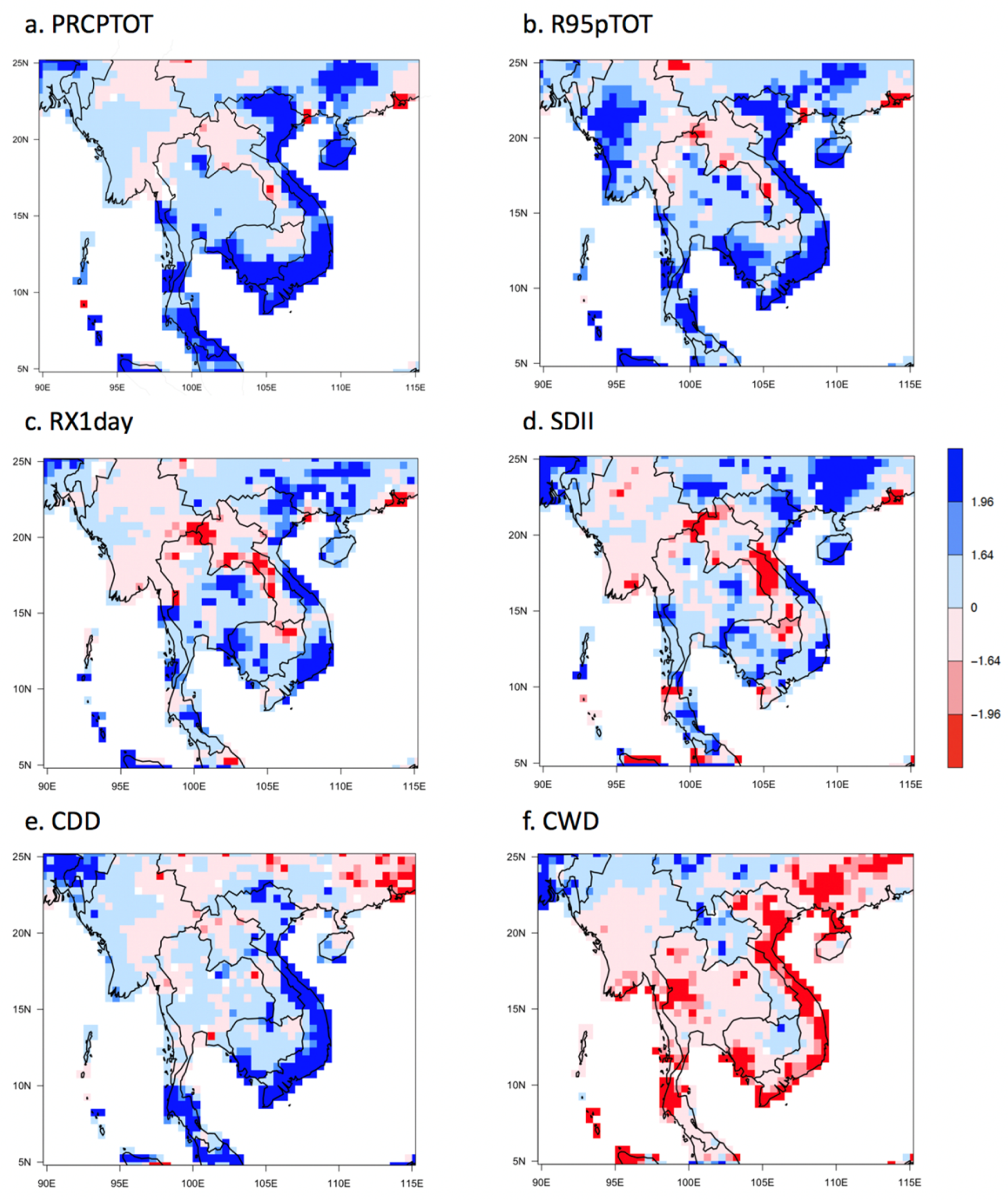
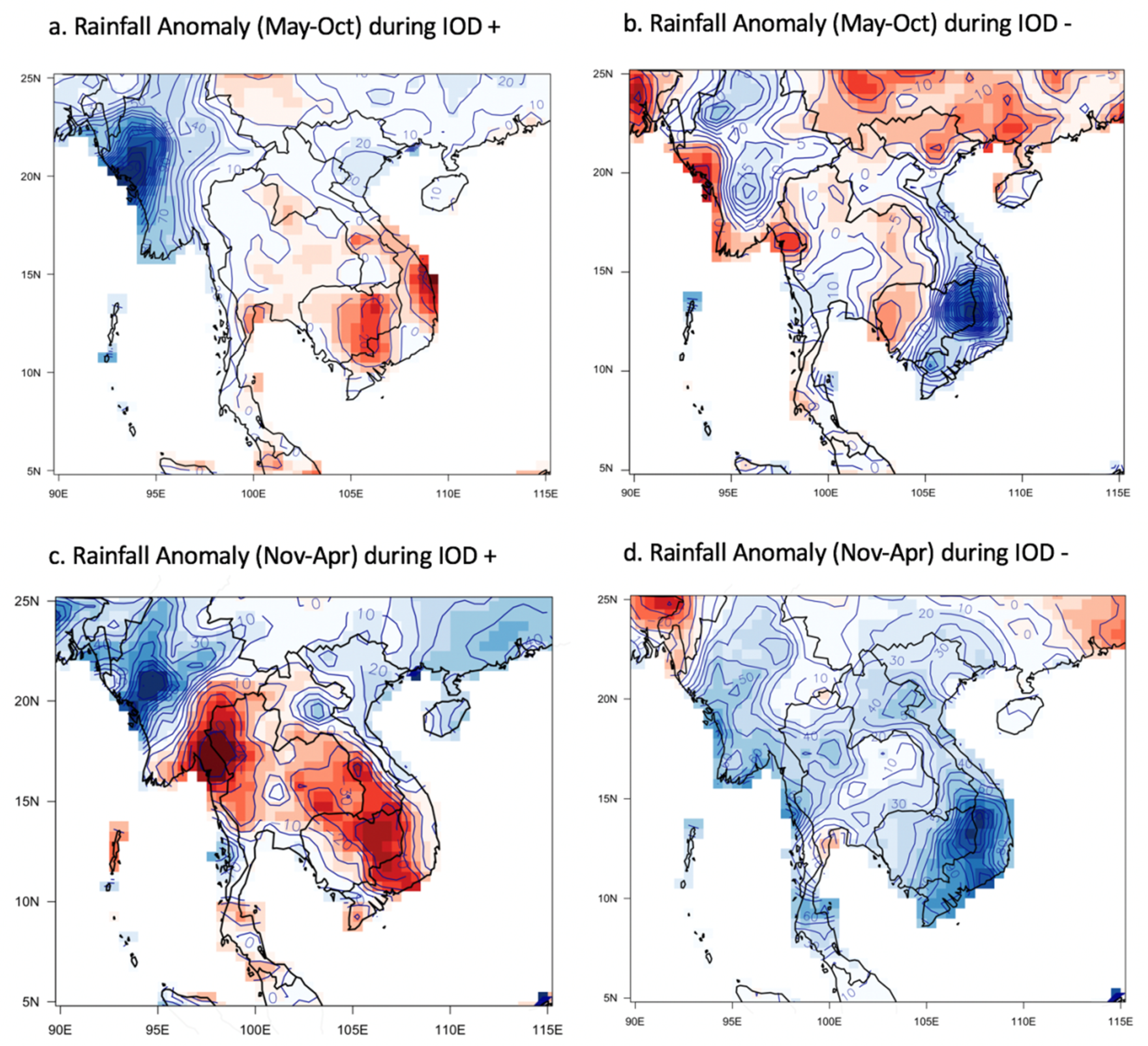

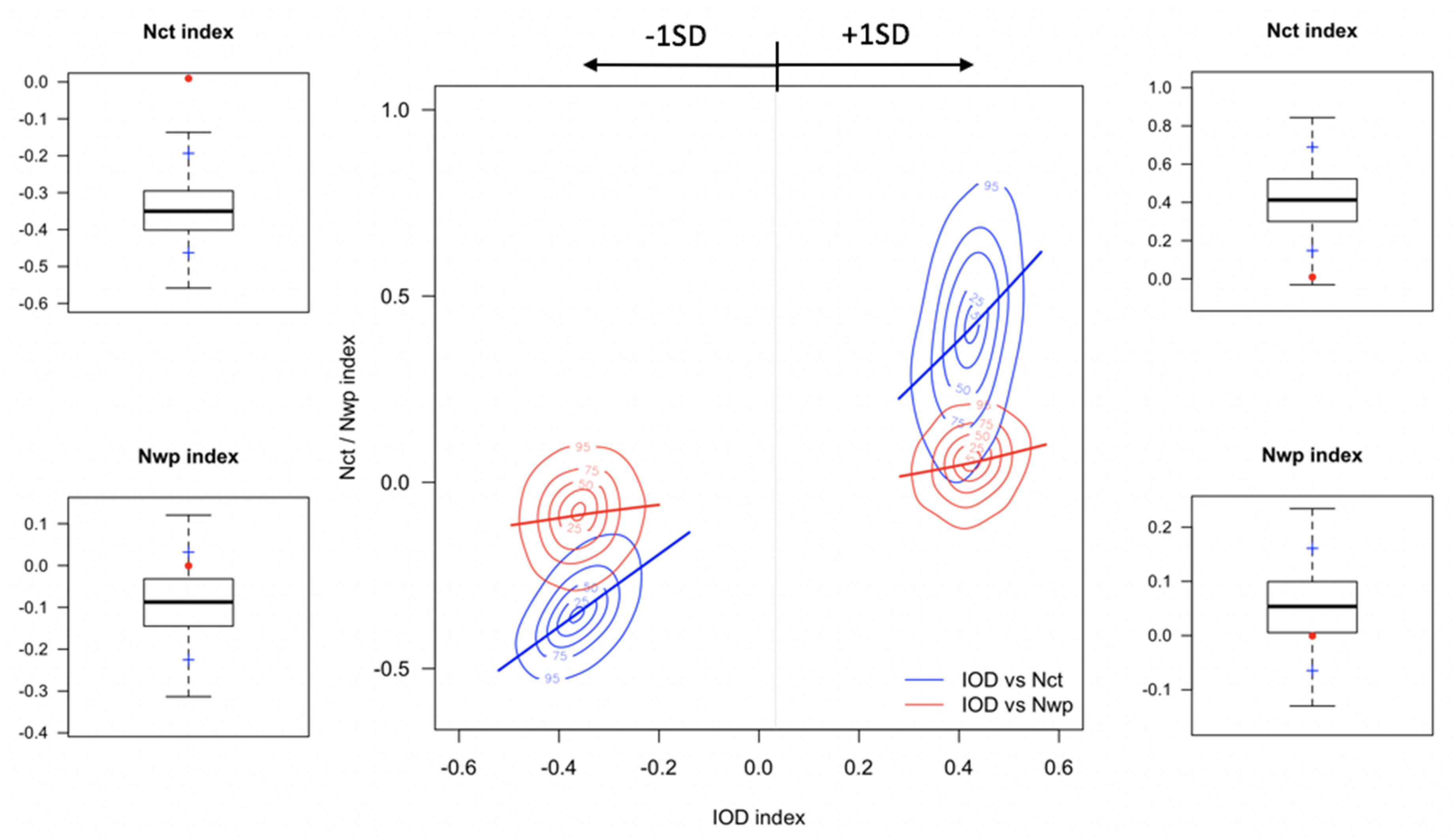
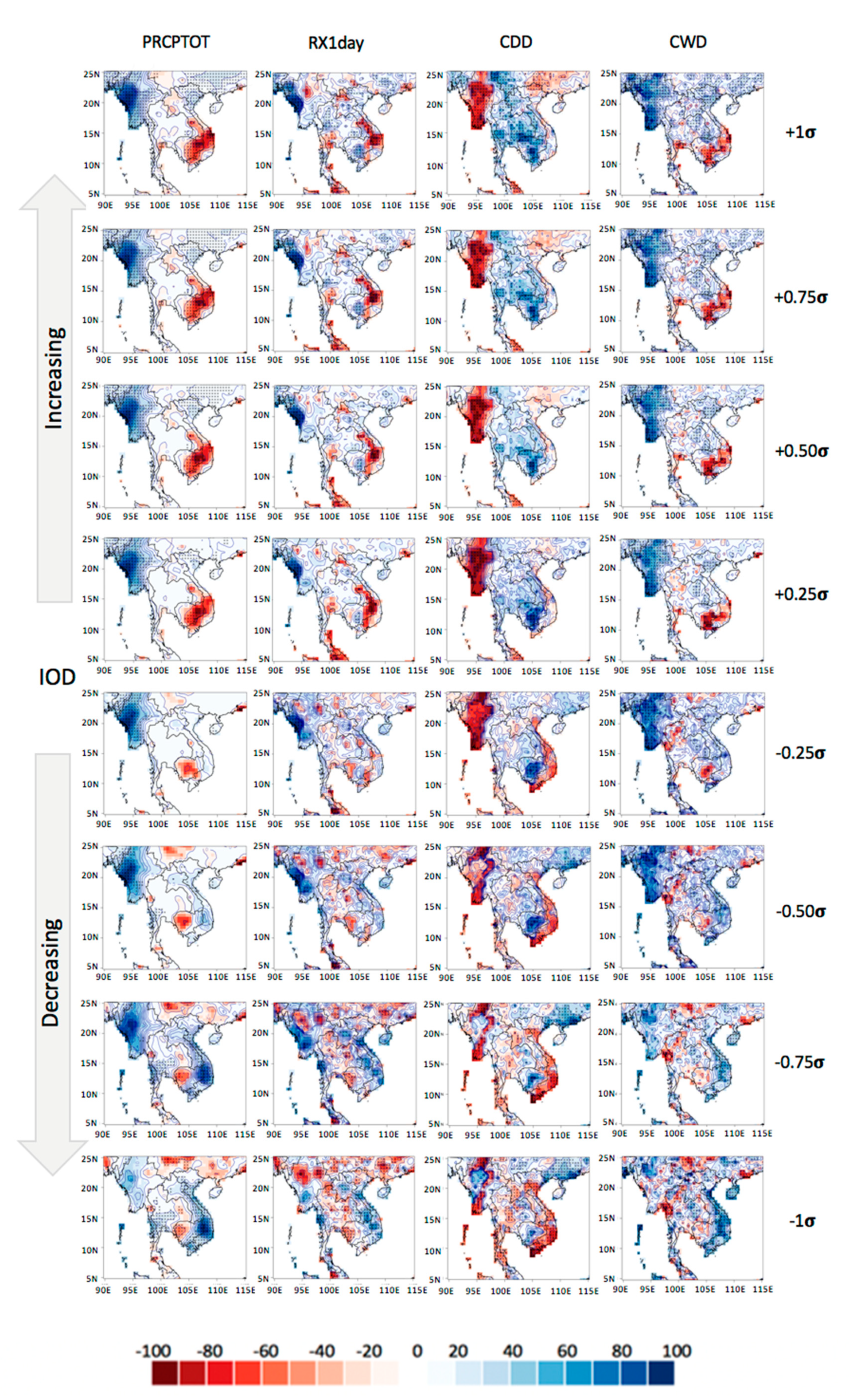

© 2020 by the authors. Licensee MDPI, Basel, Switzerland. This article is an open access article distributed under the terms and conditions of the Creative Commons Attribution (CC BY) license (http://creativecommons.org/licenses/by/4.0/).
Share and Cite
Kim, J.-S.; Xaiyaseng, P.; Xiong, L.; Yoon, S.-K.; Lee, T. Remote Sensing-Based Rainfall Variability for Warming and Cooling in Indo-Pacific Ocean with Intentional Statistical Simulations. Remote Sens. 2020, 12, 1458. https://doi.org/10.3390/rs12091458
Kim J-S, Xaiyaseng P, Xiong L, Yoon S-K, Lee T. Remote Sensing-Based Rainfall Variability for Warming and Cooling in Indo-Pacific Ocean with Intentional Statistical Simulations. Remote Sensing. 2020; 12(9):1458. https://doi.org/10.3390/rs12091458
Chicago/Turabian StyleKim, Jong-Suk, Phetlamphanh Xaiyaseng, Lihua Xiong, Sun-Kwon Yoon, and Taesam Lee. 2020. "Remote Sensing-Based Rainfall Variability for Warming and Cooling in Indo-Pacific Ocean with Intentional Statistical Simulations" Remote Sensing 12, no. 9: 1458. https://doi.org/10.3390/rs12091458





